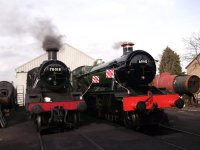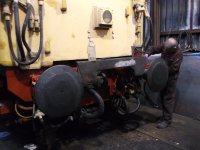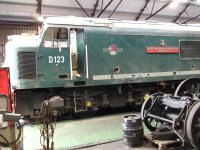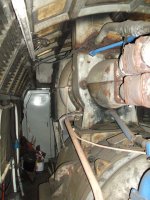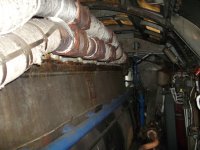Chuffer
CCCUK Member
Interesting points raised Ross. Firstly regarding " where would we be with steam power " , the railways in Britain were lagging far behind other countries in terms of modernisation to diesel and electric traction . The country was financially `broke` after WW2 and the railways had been run into the ground during the demands of the war . There was no money to invest in electrification so steam locos soldiered on with new `Standard ` designs masterminded by Robert Riddles who was the Chief Mechanical Engineer for the newly formed nationalised British Railways in 1948 . He had come up the hard way through the ranks and had studied under Stanier at the London Midland & Scottish Railway ( LMS). His vision was for a long programme of building modern and efficient locos through to the 1970`s but the last of his designs was built at Swindon in 1960 . By then the Government had embarked on a Modernisation Plan to do away with steam power and and a hastey and ill conceived diesel loco building plan was rushed through by inviting private companies to present their own designs for building . This resulted in steam locos only 5 to 10 years old being scrapped , a criminal waste of tax payers money . Numerous diesel locos were rapidly built in the late 1950`s and 1960`s and many proved unreliable due to lack of development . Some even earned a reputation for regularly catching fire !! Some classes of diesel were withdrawn and scrapped within a few years of service . More money wasted !! In the late 1950`s and early 60`s it was a matter of routine that steam locos were sent to rescue trains hauled by diesels that had failed . In fact on some rural branch lines where steam power had been eradicated by Diesel Multiple Units ( Rail Cars ) , steam power was re introduced until reliability issues were resolved with the modern traction.I find it interesting to 'conjure' where 'we' would all be with steam power if diesels engines and electric technology hadn't effectively taken over. Also given the current drive to reduce emissions.......could coal have been replaced with something else.
I've noticed that many of the engine classes, and individual engines are named after the designer or chief engineer responsible for producing the loco.........questions I have relating to that........what is really (as with Sir William Stanier) totally 'his' design........or the results of a whole team of engineers designing the engines and the Chief Engineer heading-up the deparment taking all the credit. Were people (like Sir William Stainier) awarded a knighthood because of their efforts (or team efforts) relating to the engine design........or was it simply (much as today) the 'old school tie brigade' taking the plum jobs and all the credit for the teams work.
I'd like to think that engineers, whatever their background only recieved recognition (such as knighthoods) due to individual efforts...........
With regard to Stanier , he was a `dyed in the wool` railwayman from the get go . Born in Swindon in 1876 , his father worked for the Great Western Railway ( GWR) as nearly everyone in Swindon did . Stanier started as Office Boy , then a 5 year apprenticeship in the loco workshops and then became a draughtsman ( just like me ! ) He steadily gained promotion until head hunted in 1932 by the LMS to become Chief Mechanical Engineer to resolve the LMS`s `small engine` policy they had inherited from the old Midland Railway that the LMS had absorbed with the resultant clash in personalities and old style attitudes . I think Stanier banged a few heads together and with a hand picked team embarked on a prodigious building plan of larger , more modern for the time , loco designs amounting to 11 different classes for various types of duties . This meant a standardisation of lots of components allowing efficiency of manufacture , maintenance and operation by the crews . All this came from his time learning his trade with the GWR. Yes he did have a team of very good engineers working under his watchful eye but the fundamental designs were all his . During WW2 he was selected as a consultant to the Ministry of Supply and was knighted in on retirement in 1943 in recognition of all his services . He was also made Fellow of the Royal Society ( FRS ) and President of Institute of Mechanical Engineers . As is the way of things , the Head Man` gets the gong but at least it meant something in those days rather than handing out Knighthoods willy nilly to pop stars and the like with no more meaning than sweets to a child !!!
Staniers ultimate design was his awesomely powerful Duchess Class express locos , the last built being named in his honour ` Sir William A Stanier FRS `.



















